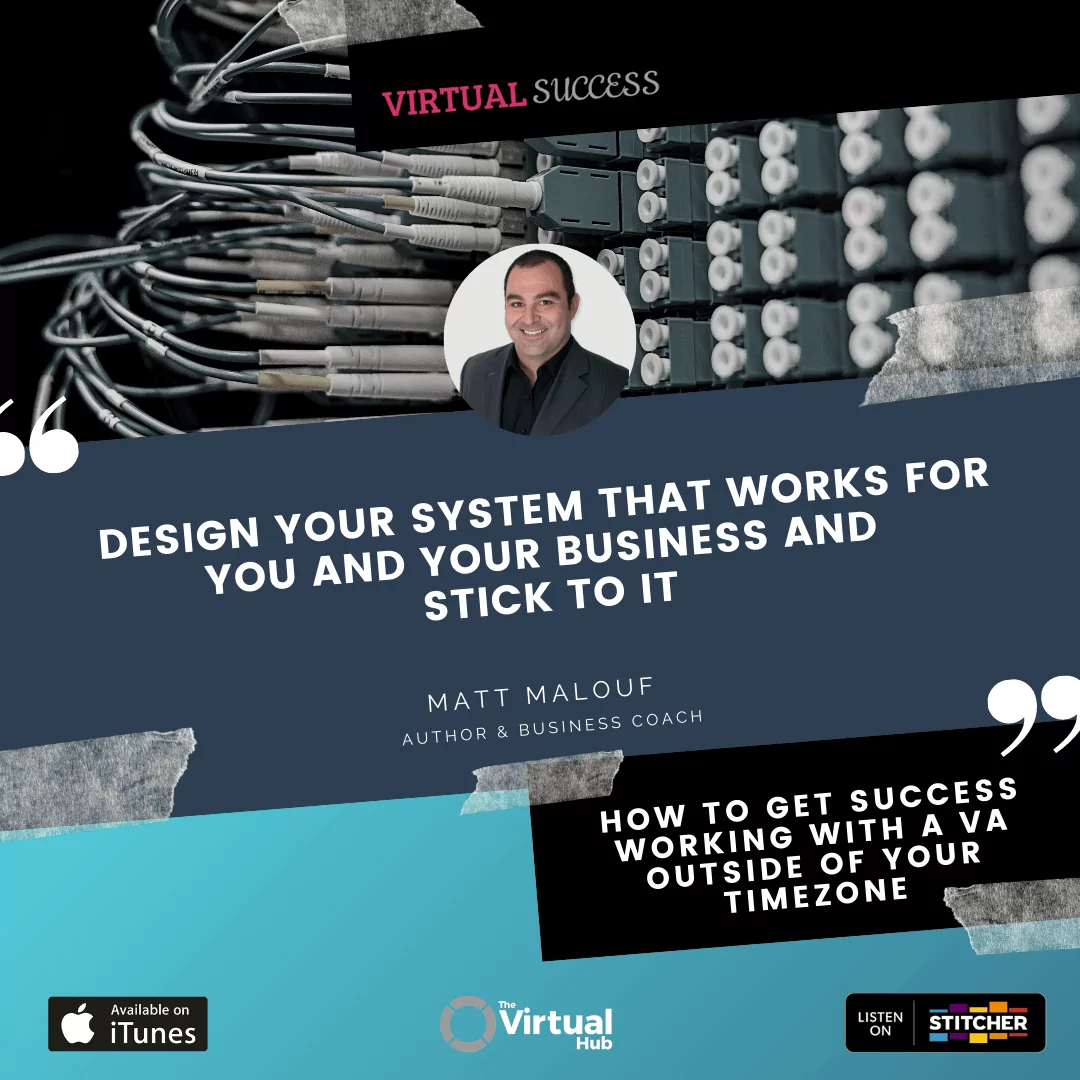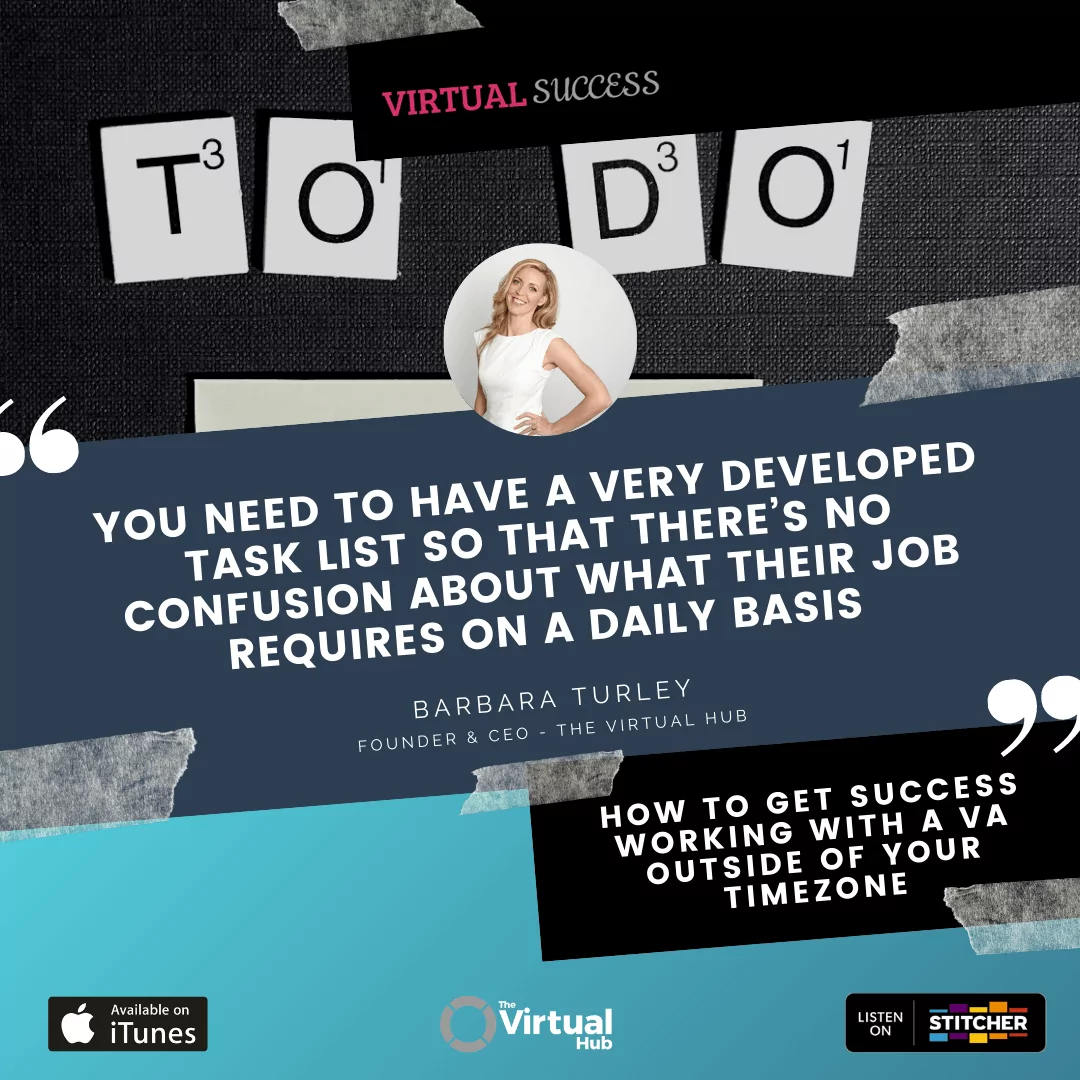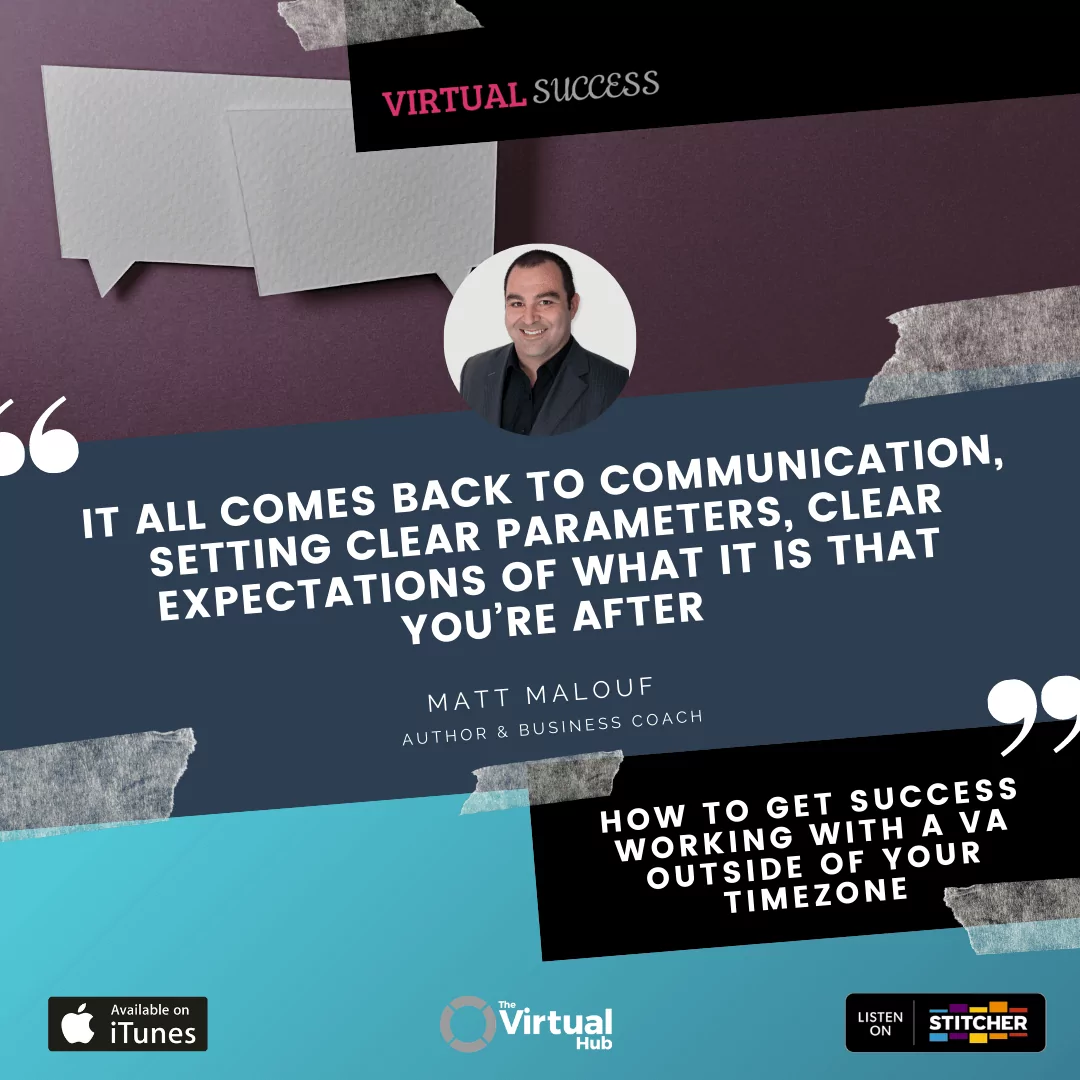How to Get Success Working With A VA Outside of Your Timezone
Want the transcript? Download it here.
In this episode, Matt and Barbara talk about how to avoid frustration with Virtual Assistants who work in different time zones as you and how to keep everyone accountable.
Some of the areas covered include:
- Tools to use for tasks and reporting
- Frustrations most business owners feel when their VA works in another country
Let us know in the comments below what your key takeout has been from this episode or why not join the continuing conversation over in the Virtual Success Facebook Group.
In this episode:
2:27 Timezones
6:21 Setting parameters and direction to avoid feelings of frustration
9:30 Designing a system that works
10:32 Stand up
15:06 Creating documentation for recurring tasks
18:21 Time, Patience and Attention to Detail
Intro: Do you find yourself running out of time to accomplish your work, are you spending time doing things that you’re not that good at? There are effective ways to outsource these tasks so you can focus on your business. This is the Virtual Success Show, we bring the inside scoop on outsourcing success for entrepreneurs by entrepreneurs. And now here are your hosts Matt Malouf and Barbara Turley.
Barbara Turley: Hey everyone and welcome back to another episode of the Virtual Success Show where I’m again joined by my co-host Matt Malouf. Matt, how’s the going?
Matt: It is. It is, and I had to think about that because we normally do these recordings in the morning but it’s—
Barbara: Great, thanks. And as always we’ve come up with a fantastic topic again today that we think the listeners, you guys are gonna really love, common problem. I love how when we’re just chatting in the planning of the show, we just come up with all these ideas that just come from our experiences with clients and, Matt you with coaching clients, me seeing people getting VA’s, brings up the most interesting stories for us.
Matt: Absolutely, and I’m really excited about today’s show.
Barbara: Yeah, so a common one and something that did come up for us recently, and I know a lot of people in the Virtual Assistant, virtual team game out there globally would have this problem, is how do you get success when you’re working with a virtual team or a Virtual Assistant that is not in your time zone?
So for example, you’re in the US working, your business hours and you have a VA in the Philippines who works their business hours. So therefore, it’s in the middle of the night for you, which sounds like the Holy Grail because the idea would be that you wake up in the morning, and all these amazing tasks have been completed overnight.
But often we find that, while that does seem like the optimum solution, it doesn’t always work out that way. So, Matt, I’m sure you’ve seen this with people who have offshore VA’s and overseas contractors.
Matt: Absolutely, and I’m, and I’m like, I’ve even seen it to the extent of where Australians are working with Filipinos where there’s only a couple of hours time difference. Don’t get this right. So its-
Barbara: There’s a couple of extra tricks I think to getting this right. The…
Matt: I agree.
Timezones
Barbara: I think all of the things that we talk about on this podcast all still hold very true. But when you’re working different shifts and different time zones from each other, you almost need to like crank up the fuel on all the things that we talk about and you need to be extra vigilant with so many things.
Of course that means, using things we always talk about, project management tools like, Asana or Trello, whatever, using Slack effectively, making sure that you’ve got really detailed processes and task lists, et cetera. But there’s a little bit more to it than that, isn’t there Matt, to get this right?
Matt: Absolutely.
Barbara: Yeah, so we had a case of this, the reason this is an interesting one for us. We had a case of this come up only a couple of weeks ago, where one of our clients had requested that they would like to have a VA working outside of their time zone. And after a couple of months, it came to light that it wasn’t really working out.
So we got in there and actually have helped to boost the situation and get things working more effectively. So one of the things that, and I actually also have, one of my team works in my nighttime. And we have an amazing relationship, gets so much work done yet we never have a live call together.
So what we’re gonna do today, is kind of dissect the important points to getting this right. Number one for me, and something that I definitely do. I mean, we always recommend having a non-negotiable kind of huddle, meeting every day with your team just to make sure that you answer questions on where they’re stuck.
But how do you do that if somebody is not in your time zone? Well, the way I’ve been doing it is, I still have a huddle with my guy who’s not in my time zone. He said, we do it over Loom. And I’ve given him a structure where I say, “I want you to do a video for me on Loom, every day.”
And it’s like, “Here’s what I’ve achieved for the day, here’s what I plan to do next, here’s where I’m stuck.” And then I ask him to give me a solution. So I go, “Here’s where I’m stuck.” And he lists out all the questions he has for me. And then he goes, now what I’m thinking is this, I just don’t know, I need your feedback.
And then, I do my Loom video and I go back to him, and we trade Loom videos basically. And it works really well for us because, we’re diligent about it.
Matt: When does he have to have that done by, Barb?
Barbara: It’s like an end of day report thing. So I wake up in the morning if his video is there.
Matt: Excellent.
Barbara: It works pretty well for me, and then I’ve got the whole day to kind of come back to him, now, I have been guilty of not going back to him. And then I’ll be honest with you, if you don’t go back to them, if you don’t deal with that straight away, it’s like anything for days can go by, so you have to be extra vigilant with yourself.
I think, if you’ve got somebody who’s not in your time zone, it’s a commitment on both sides to do it.
Matt: Agreed, and I think what, I want the listeners to hear from what Barbara’s saying is, she’s just taking the framework that she uses with her team and adapted it utilizing technology. So we’ve gone, what’s the barrier that is actually occurring in its current form? Well, when I’m sleeping, he’s awake and when he’s sleeping, I’m awake.
So we’ve gone, what’s the compromise? Same questions asked as a normal huddle, and we’re just utilizing technology here. I think that, you bring up a really good point too, which is in responding because, like any of us, if we are doing something and we don’t get a response, we’ll just stop doing it.
Barbara: Well, they get even more stuck, because I find my guy, everything’s stalls and I could blame him for that, or I could go, well, he kind of doesn’t really know where to go next, because I haven’t given them anything.
Setting Parameters and Direction To Avoid Feelings of Frustration
Matt: Yes, and I think that’s a really good point when we talk about different times zones is, having some parameters around what to do when they do get stuck because, we don’t want your Virtual Assistant feeling frustrated. We don’t want you feeling frustrated that, I need to have their handheld but there’s gonna be this middle ground because, if they just go ahead and keep doing things, it’s likely to cost you time and money.
But if they don’t get timely responses from you, again, it’s gonna cost you time and money. So, I think this… And Loom, I mean, I don’t know about you but I love Loom.
Barbara: I’m addicted to Loom, I love Loom.
Matt: It’s so simple, easy, it’s there. And for anyone that hasn’t, utilized Loom, it’s a Google Chrome Extension. I was gonna point…..
Barbara: Yeah, it’s a Google Chrome thing.
Matt: Extension?
Barbara: The tricky part is this, the Web address is use loom.com. You use as in, U-S-E, to me, just to find the thing, because I couldn’t find that URL. But use loom.com, if you go there and if you go into the Chrome Extensions, you can put it on your desktop, it’s really handy.
Matt: Correct, now……
Barbara: I think as well the thing about the video though, you could, so of course you can type. I think one of the other things I do, which I forgot to mention, I do the Loom video, but then I also put in bullet points into Asana. So I drop the Loom video into Asana, so I still use Asana but then, I put bullet points as well into Asana of kind of the dot points of what I’ve discussed just to… I mean, I’m a talker, right?.
So just to sort of get it into a more, less of a blurb framework and to make sure that he has all the points that I hit in the video. And I think that helps him to then put some structure on everything I’ve said, if I ramble.
Matt: Yeah, and I like how you’re not compromising one system for another, we still use both. And, let me ask a question about, when you do your huddles with the rest of your team, does everything go into the Asana?
Loom and Asana
Barbara: Yes, so the rule we have, and I learned this the hard way, so definitely listen up guys, because I did this wrong initially. I used to think, well I used to say, constantly find myself saying to the team, “I discussed it on the huddle and then I became kind of like that tone about it.”
So it was like a thing in our whole business where I was getting really frustrated going, “But I told you this on the huddle.” But the reality was the huddle had become quite big and we have about 12 people on there and there’s a lot of things that get said on the huddle. So the rule is, we actually have one person for each section, is kind of a note taker.
And they have to put the instruction into the task as we go through the huddle and tag the person that is now gonna take it over. And we do it live so we can all see, and sometimes I might say, “Oh! Will you add this there.” Or, “Just make that clearer by saying whatever and I can add my thoughts.”
So definitely adding the bullet point or the pure instruction into Asana in the task is key, and that solved that problem for us.
Designing A System That Works
Matt: Yeah, and everything that Barb was talking about here is so simple. And it’s a case of number one, designing your system that works for you and your business, and number two, then sticking to it. And the accountability has to go both ways with something like this, we can’t have an expectation on your Virtual Assistant that you’re not willing to uphold on your end.
Barbara: As I was saying this as well, I was thinking, the tendency is, and I did do this myself. The tendency is to go, “My team aren’t listening, they’re just not listening.” But they are listening, it’s just that, you may need that extra step and it just cleans everything up. And definitely someone not in your time zone, definitely put that step in as kind of a circuit breaker to make sure that everyone’s clear.
Stand Up
Matt: So we have a slight variation on the way we do that in our business, to what you’re doing about where, we have a Slack channel called, Standup.
Barbara: Yeah, I love that.
Matt: And we just, because we call it Standup because, how to…….another term for a huddle is a Standup meeting, so we call it Standup. And in our business, we don’t have American time zone, but the time zones that we do have, vary from, New Zealand, Australia and the Philippines.
By 9:30 Sydney time, everybody has to put their standup. And we have a three really simple questions. Question one is, what am I getting done today? And you need to bullet point the key things you’re gonna be working on today. The second question is, what do I need from others slash where I’m stuck? And again, you can you put it in there.
And then the third question for us is, did I achieve yesterday’s tasks? And the nice thing about that, particularly in my role, because I travel a lot, I rely heavily on Slack as a communication forum in our business is that, I know that I can keep my team on task and focused simply by, monitoring what they’re putting in their Standup.
We utilize Asana and the like also, for recurring tasks and projects. But this enables me to know, where their focus is, but also to, for instance, in today’s, Standup, one of my teams said, “I need a decision from Matt today on this event.” So, and I knew that I needed to do that, but it was just, that’s what that person needs in order for them to keep on track with their projects.
We had another team member who is a little bit low on work at the moment. So she’s come back and said, highlighted to the whole team, “If anyone needs any assistance or help, I’ve got some excess time today.” So it’s serves in a few different, I guess areas, but I just like that I can log into, Slack whether it’s on my computer or my phone and say by 9:30 every morning, everyone in our team has posted in there.
Barbara: Yeah, I love that. And I think, not only just to keep everyone focused, it keeps them all focused on what your needs are as the owner of the business, as the leader of the business. In terms of what report, like what do they need to tell you? Because I think, I find sometimes, when I talk to VA’s, they sort of don’t know what to put in their end of day report or, they’re confused about, what does the client need to know?
And they end up listing all the tasks they did for the day, which is kind of useless. And this whole thing helps your team to get really clear about, what is it that you need to know as the leader of the business so that you can make faster decisions? You could help them, you can make sure roadblocks and friction doesn’t happen.
And on the other side, on the more negative side, there’s nowhere to hide. So for example, if you do have a team member, like I hear a lot from people, I just don’t know what my VA is doing, I don’t, there’s all this. In this structure, you won’t have that problem, because they have to do this every day.
And you’re gonna see very quickly where their strengths are, where the holes are, whether nothing’s happening, or whether they’re just not doing it, and that produces then a different conversation. So it makes leadership of teams and actually managing more of the HR side, or more the performance management actually easier, because it gives you the tools to do it.
Matt: Yeah, and the other thing too, just to add to that list that Barb was saying, “It enables you to understand, are they prioritizing the right things at the right time?” Sometimes, it could be that you had a meeting and, or it could be your Loom video and something was missed and then all of a sudden you’re not seeing it, whether it’s in Asana or in the Standup conversation, you can remind that person that, “Hey? How about this thing that’s a really important, that they see get done today.”
Creating Documentation For Recurring Tasks
Barbara: Yeah, so look, I think those are, definitely that’s the big thing for me. Another key thing with someone outside your time zone is, and I know we’ve talked about this a million times, but you need to have a very developed task list so that there’s no confusion with that person about what their job requires on a daily basis.
Now, someone outside of your times zone could be doing a recurring task list, a project task list or a combination of both. And it’s very, very important for you at the beginning that that task list is developed enough in terms of, systems and processes and instructions so that the person can actually effectively work without you.
So it requires a little bit higher level of detail, I feel. If it’s a project, then that is a little bit harder again because it’s not so clear cut. So you just need to think about that and raise the level of involvement initially from you to make sure, that actually is structured properly and they can get on with the job. Does that make sense, Matt, so that, because they’re on their own, right?
So they have to be able to get on with the job without you, and then report back to you at the end of the day, on where the challenges are, et cetera, and what’s been happening.
Matt: And remembering that they crave instruction, actually want the instruction. And the, that those recurring tasks lists, or whether it’s adult task lists, make it so much easier for your VA to win which in turn means that you win.
Barbara: Yes, a final one I think I would touch on just, which I think is a trap that some people would fall into if they’ve done all these other things is, the terrible trap of research. So naturally a lot of VA’s, this happens to them. You’ve asked her VA to do something for you and they go into the vortex of research.
And because it’s not in your time zone and you’re not available, and nobody’s really helping them during the day, they can go in and all of a sudden you get a time tracker or an end of day report or whatever that says that, they spend three hours researching this one thing and you had no intention of that happening.
And you were like, “Oh! My God, three hours for that?” So again, that comes down to effective, knowing that you’re not in that time zone. Again, this stuff is really important if you are in a time zone, but if you’re not, you want to lay the expectation out and help the person before they start that task with, what your thinking is.
So you might say, “Look, I want you to do some research on this particular topic for me, I don’t really, if you’re finding your spending more than an hour, I want you to stop and compile what you’ve done and I’ll, we’ll think, will do more tomorrow.” Or something like that, “Let me know what, where you’re, what you’re finding.”
So that they have some parameters around, that vortex because it is a vortex that they can get lost in for hours on end. And it, clients get very irritated with that, that’s the one like pay, it’s sort of something that really, irks a lot of clients and it’s like, it pushes their buttons of, “What’s my VA doing all day?”
Matt: Yeah.
Barbara: Causes that a lot, yeah.
Time, Patience and Attention to Detail
Matt: And it all comes back to the communication. Setting clear parameters, clear expectations of what it is that you’re after, when to check in, et cetera. And I think we at the, on the other side of what Barb was saying, if you need someone to go deeper on something, then you need to say, again, allow them to understand the depth of research that you’re after so that they cannot allocate enough time. They may go to short and not go as in depth as you would like.
Barbara: Absolutely, yes. Again, that’s mind reading. Like how do you know? So it’s all of these assumptions around, what you say and what someone else hears and you just gotta be more detailed, I feel when somebody is not in your time zone. And then you won’t waste time together and you can’t have a really effective relationship actually.
And you get that Holy Grail of waking up in the morning and going, “Wow! Look at all this stuff?” That actually does happen.
Matt: You need a mind reading tool, that’s what’s we need though.
Barbara: Yeah.
Matt: That would solve this problem for everybody?
Barbara: Yes, I think, again, I always say, it’s a commitment to, I find myself writing instructions now and I’m stating the bleeding obvious kind of thing. But I just know that, you just, in any communication, like the other day I was in a coffee shop and this girl, I ordered like two large flat whites. It was a whole list of things and she was new.
So I said, “Why don’t you read it back to me to just, make sure he got the right order?” And she said, “Okay, so you want two coffees, one toast.” And I said, “Okay, it’s too large flat whites, because my husband would go mad if it was wrong. It’s one soy Lindseed toast with butter and jam.” Right? Because, otherwise you could get an order that was totally wrong.
So it’s this, just commitment to the detail that can be tedious for a lot of people, but it reduces the, reduces mistakes and misunderstandings.
Matt: It does, and I think again, like with any person you’re working with, when you’re working with people across different time zones, you’ve got to be patient and you’ve got to understand that there is a getting to know one another phase and you really got to find your groove together. And that’s where there someones, sitting next to you in your office or they’re on the other side of the world on a different time zone.
You’ve got to be, set realistic expectations in the short-term in order to set yourself and the other person up to win as well.
Barbara: Look and I will share, by the way, I mean, you might have someone who’s not a Virtual Assistant, you might have a consultant that’s working in another time zone. You might as in someone from your team, you might have a salesperson. Like I’ve got, I live in Australia and I’ve got a salesperson who runs the U.S sort of sales side, who is in a, is like literally the opposite end of the time zone to me.
And we have had all these, like we’ve had all these stumbling blocks because of these issues again, and you have to be very clear. And so it doesn’t, it’s not just about talking about Virtual Assistants, it’s anyone who is working a different time zone to you or in the virtual environment I would suggest.
Matt: Correct.
Barbara: Great, well, I hope that has helped a few people out there listening. I know, I definitely know this is a thing out there. And don’t get discouraged to that just because somebody wants to work in a different time zone or a few hours different to you that you can’t make it work, but you have to make a commitment to these few steps that we’re talking about here.
Matt: Absolutely, and if you’ve got any questions on this topic, please feel free to send them through to us via the Facebook group. We’re always looking for new topics to talk on the show as well. And as I said, “Please, we’d love for you to share the episode out there in the community so we can help a lot more businesses and entrepreneurs succeed with their virtual teams.”
And if you’ve enjoyed the show, we’d love for you to write us a review and again, share the love, because the more people that Barbara and I can help in this area, we believe, the more successful the entrepreneurial community will be.
Barbara: Absolutely, well said. Thanks guys. Until next time, see you soon.
Outro: Thank you for listening to the Virtual Success Show. If you found this show helpful, take a moment to share it with a friend so that we can all grow together.
The Hosts
 Matt Malouf
Matt Malouf
Matt Malouf is a passionate business coach, speaker, author, and entrepreneur on a mission to help entrepreneurs around the world break the shackles of mediocrity and reach new levels of personal and business success.
 Barbara Turley
Barbara Turley
Barbara Turley is the Founder & CEO of The Virtual Hub, a company that specializes in recruiting, training, and managing superstar ‘Virtual Assistants’ in the social media, digital marketing, and systems automation space.




 Matt Malouf
Matt Malouf Barbara Turley
Barbara Turley